
Ann Shelton, Photo by Bonny Beattie
Q&A with Ann Shelton
30.9.20
New Zealand artist Ann Shelton will be premiering a new work about Lola Montez at PHOTO 2021 in partnership with the Metro Tunnel Creative Program. Here she talks about her experience as a photojournalist and photography's malevolent capacity to obscure, misrepresent, confuse, or mask the truth.
What started your relationship with photography?
I grew up in small-town Aotearoa New Zealand, in the South Island. I don’t know my ethnicity on my father’s side but my mother’s side is Pākehā (a Māori-language term for New Zealanders primarily of European descent). The epic South Island landscapes, South Canterbury rivers and the man-made hydroelectric lakes of the Waitaki River were the places my family retreated to on holiday and for recreation. I experienced a sense of alienation as a young woman. This, and my working class childhood, has been a driver in my work.
In Aotearoa we speak about a “Southern Gothic” in the South Island but my SG was not the European romantic version, it was populated with car wrecks and bogans with mullets rather than mountains and castles. The South island was and still is a violent, isolated, conservative place, which operates sytemically in a way that maintains racism and inequality here in Aotearoa. In my work I am unveiling and uncovering aspects of the silences created therein, and I have chosen a medium which is equally conflicted and compromised to do it. That seemed like the right call to me. Relate the form and the content of the work in a tight little knot: look at the mechanism of photography as well as the product (being the image). As I have said elsewhere:
“Photography is a bit of a bitch. It has been a willing accomplice in this whole imperialist project. Photography, of course, is imperialist by its very nature, tied to colonising and capitalist technological development. But photography can also be used against imperialist ideology. It has an agency and a power that does not necessarily come from where you would expect, and it can be wielded in unique and emancipatory ways. It is this duality that got me interested in the medium as an artist and it has kept me engaged all this time.” [1]
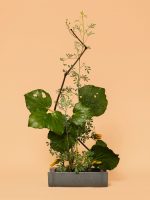
The Mother, Rue (Ruta sp.), 'jane says', 2020, archival pigment print, 112 x 84 cm
How do ideas relating to 'The Truth’ factor into your practice?
My first career as a press photographer catalysed my interest in the malevolent capacity of photography to obscure, misrepresent, confuse, or mask the truth. This early career on a national New Zealand newspaper only sought to deeply complicate the medium for me. As a result, I decided to quit and go to art school. Being a photojournalist generated a myriad of questions around photography for me, around notions of truth: whose truth, which truth, who gets to tell their truth, how is the telling of a truth a mechanism of power and dominance etc?
Early on in my artistic trajectory I was very interested in the genre of documentary photography and how it can intersect with a photographic practice driven by ideas. A lot of my artistic production in the first 20 years of my career can be contextualised, on one level, as a critique of documentary photography’s claimed objectivity. You can see my art practice as marked by a shift away from what Henri Cartier Bresson called the ‘decisive moment’ (Bresson wanted all the visual elements in an image to be lined up and perfectly positioned in order to tell the story or provide all the relevant information) and a move towards examining how ideas and concepts circulate through and with images. Then leading on from that, an examination of how images can be opened up to multiple possibilities, meanings and positions.
How do images encapsulate narratives, urban myths and multiple ideas of truth? How can we split the photograph apart to make it less sure of itself, more of a stammer rather than an emphatic attempt to summarise or crystallise a singular meaning or truth? Is there such a thing as truth, fully formed and whole? I am attempting to duplicate, reverse, split, transform, narrate alternative perspectives and most recently perform meaning outside of monocular image making via a kind of plurality or what I have sometimes called a stammering. I have adopted this strategy in order to prompt different potential positions for viewership and to foreground the importance of the viewer’s individual cultural and social construction and their own engagement with the process of creating meaning through a photograph.
I also have an ongoing interest in visuality and in unpacking how meaning is constructed through the mechanism of photography, what has been called our ‘habits of vision’. I utilise devices and methodologies in my work that are both formal and aesthetic and that are a reference to the roles that photography has played in constructing meaning in our lives, for example in jane says that happens through the co-option of aesthetic devices from advertising and from the photography of domestic rituals like flower arranging.
My new jane says works are about to be exhibited at Sydney Contemporary 2020 which is an online art fair you can check out from 1 October 2020.

The Sibyl, Sage (Salvia sp.), 'jane says', 2020, archival pigment print, 112 x 84 cm
In this post-internet age, how do you see the viewer in relation to your artwork?
Technological development presents a myriad of new opportunities and with that, new ways to make art. Nothing will ever be the same, and post the multiple COVID-19 lockdowns, everything has changed again. The materiality of exhibitions is forever challenged and likely transformed. Our understanding of our destructive roles in relation to our precious planet are also foregrounded and highlighted to us in new ways. This devastation also brings the potential for collective change.
Artists play a consequential role in helping us understand and navigate new kinds of embodiment, collective action and new ways to distribute power. The question of viewership post COVID-19 is a fascinating one, set to unravel in front of us in the coming months. The internet does many things very well. However, providing the profound and transformative experience of viewing an artwork that is physically right in front of you, is not usually one of them. Distance viewing or remote and internet-based viewing seems unlikely to be a long term substitute for viewership as we know it, but it will be a much more prevalent mode and it will have its upside as more people are able to engage with diverse creative material in far flung parts of the world.
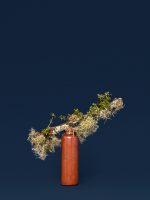
The Witch, Penny Royal (Mentha sp.), 'jane says', 2020, archival pigment print, 112 x 84 cm
How do you go about developing new projects?
My projects are generated out of intersections or confrontations with specific knowledge. This might occur via films, conversations, online engagement, however, these moments are most often catalysed through reading. Once an interest area is gelling and I have decided it is relevant and part of a progression within my practice, I will move into research and developing ideas around how I will photograph it, and make it present in my images, performances and/or printed matter.
I am an avid consumer of non-fiction materials related to the projects I am working on, with jane says there was so much fascinating material that took me from the markets of ancient Greece to the legal cases of New York around self-induced abortion. I want to convey that journey to the viewer in some way, shape or form. Jane says is made up of a series of large photographs and a performance artwork entitled The physical garden. The perfomance is approximately 20 minutes long; the performers read quotations that I have assembled from this research such as:
“Māori women used poroporo (Solanum laciniatum and S. aviculare) shrubs as contraceptives. They boiled leaves and drank the broth about a week before menstruation. The efficacy of the decoction as a method of birth control is not known. In Taranaki in the late 1970s and early 1980s, poroporo shrubs were grown for solasodine, a steroid used in contraceptives. When it proved cheaper to raise such plants overseas or use synthetic substitutes, poroporo was no longer cultivated in New Zealand.” [2]
The two performers dissect plants while narrating these vignettes in a conversation which transcends time and discipline but marks out the power of plants. The physical garden looks at the scientific, botanical, political, legal and social contexts surrounding the use of these plants. The sources include astounding works like Eves Herbs by John Riddle, witchcraft websites, botanic and gardening books, and new histories of plants such as The Cabaret of Plants by Richard Mabey, and The Big, Bad Book of Botany by Michael Largo. There are also post-apocalyptic and almost science fiction texts, like The World Without Us by Alan Weisman, and profound feminist re-evaluations of the discovery narratives around plants such as Londa Schiebingersʼ Plants And Empire: Colonial Bioprospecting in the Atlantic World, and encyclopaedic or dictionary-type treatises such as Susun Weedsʼ Wise Woman Herbal For The Childbearing Year. I am interested aspects such as genetic engineering, medical histories, pharmaceutical commercialisation, non-traditional and non-Western knowledge systems around plant medicine, etc. At the heart of all this is an attempt to reconfigure our relationship with nature.
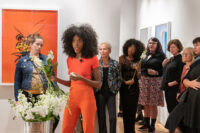
The physical garden, Denny Dimin Gallery NYC, performed by Sasha Boykin, April 2019
Who or what inspires you?
Anne Imhof, plants, female adventurers and trailblazers like Margaret Sparrow, Monica Brewster, Maria Sibylla Merian, Jacinda Ardern, Marama Davidson and my New York gallerist Elizabeth Denny of Denny Dimin Gallery, and Wairarapa Eco Farms – the community supported agriculture group that I am a member of. They’ve grown mine and my partner’s food for the last 15 years (The farm is the subject of a new body of work entitled mother lode which has just been shown Bartley + Company Art, Wellington). John Miller, a New Zealand Photographer who should be much more widely known and writers I have worked with, such as Pip Adam, Robyn Maree Pickens, Heather Galbraith, Jan Bryant and Cassandra Barnett, who light things up in new ways.
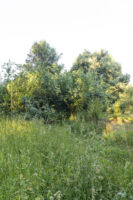
Untitled (mother, earth mantle), archival pigment print, 1120 x 760mm, 2020 from the series 'mother lode'
What books are you currently reading?
Performance in Contemporary Art by Catherine Wood. Everything is Relevant: Writings on Art and Life, 1991-2018 by Canadian artist and my Masters supervisor, Ken Lum.
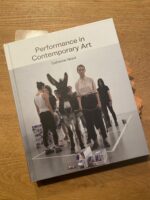
Performance in Contemporary Art by Catherine Wood
What is your favourite website / social media account?
Hyperallergic.com is my go-to art news website. Lately, I have been listening to E-Flux podcasts, Mack Book’s Instagram lives and any other qualty online art content I can lay my hands. I have been attending the Town Hall zoom meetings (a new initiative in Aotearoa to discuss key questions for contemporary artists around politics an art) and the Frith Street Gallery’s screening of Tacita Dean’s amazing Event for a Stage, 2015 online earlier this year.
Instagram is hard since they have stopped showing us who we want to see and started showing us their curated content and much more advertising. However, I love @clarestrand_stumped @anonymouswomen_archive and @pleasuregardenmagazine. I am also big fan of @handwritten_signs @chachhere and @alokvmenon and the amazing New Zealand fashion label accounts of @otsumagic, @rachellong__ and @lelajacobs.
What music are you listening to?
Siouxsie & The Banshees, Neneh Cheree, Broken Bells, Young fathers, Janelle Monae, Connan Mockasin, Inna Modja, Pierre Kwenders, Boloji.
If the work you are presenting at PHOTO 2021 was a song, what would it be?
Joanna Newsom’s “Have One On Me” which is about Lola Montez, who is of course the subject of my work for PHOTO 2021. To find out more about Lola Montez follow the new Instagram account I have created as a site for information and opinions about her remarkable life.
How did you spend your time in the lock down? Has this motivated you in a way that you might not have expected? Are you working on something new?
I was privileged to have a really productive and consolidating lock down. I was able to make the most of it, I caught up on a myriad of neglected tasks, I set up my studio as I recently became a full-time artist. I also wrote applications and proposals, and rather sadly reworked canned exhibitions, I gave my website annshelton.com a refresh and brought in e-commerce for the sale of my artist books.
Making my own books and printed matter has been a key part of my artistic output alongside exhibitions and performances. These artist books are a critical component of how I resolve this process of making and developing new work and the crew at PHOTO 2021 asked me to make a little video for you about one of them over the lock down – here it is:
I was in isolation in a relatively remote part of New Zealand, the Coromandel. It’s a stunningly beautiful place with an incredible local Māori history that I would like to acknowledge (the prominent local iwi group in my area is Ngāti Hei). The area also has an exceptionally warm climate so I can grow plants there to photograph more easily than in my home town of Te Whaganui a Tara, Wellington, which is notoriously difficult for gardening.
Do you have any unrealised projects you would like to work on?
Far too many to go into here! I have lists and more lists!
[1] Joy Gartnett, Ann Shelton interviewed by Joy Garnett
[2] Tolerton, Jane. (2011). ‘Contraception and sterilisation – 19th-century contraception’, Te Ara – the Encyclopedia of New Zealand, Retrieved November 15, 2016 from http://www.TeAra.govt.nz/en/artwork/26966/poroporo-plant